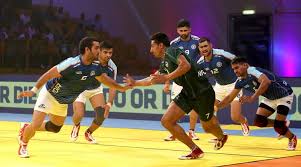Kabaddi is quick chess with contact. Two teams line up on a small mat. A raider crosses the midline, looks for a clean touch on a defender, and sprints back to his half before the pack wraps him up. If he returns, his side earns points for the touches he made; if the defense pins him, they score instead. That loop takes seconds, then resets. The joy is how fast a calm shape turns into action: one step draws a reach, a feint opens a lane, a late angle closes it. Watch ten raids, and you’ll begin to see patterns – who baits early, who protects the corner, who arrives second to seal the exit. Once your eye finds those details, the game stops looking wild and starts to read like clear, short scenes.
Where a raid is won or lost
A raid is decided by space, timing, and nerve. Good raiders test the edge, show a hip, steal a tag, then pivot low and drive home; good defenders hold shape, narrow lanes, and hit in pairs, so the runner cannot turn. If you want a compact primer before a match, the guide at kabaddi betting parimatch lays out the court and scoring in plain words, so your eyes know where to look once the whistle blows. On live play, ask one question each time: where is the exit path? Corners guard the straight run; covers close the cutback. If a defender bites too early, the raider punishes the gap. If the raider stalls, the clock squeezes him, and the tackle comes. Read the start, and the finish makes sense.
Scoreboard cues that tell the story
The score isn’t just a number; it’s a mood chart. A simple touch-and-back is one point. A bonus (toe across the bonus line with defenders set) adds another when the formation allows it. A tackle that drops the raider short flips the point the other way. If the defending side is down to three men or fewer, a successful tackle becomes a super tackle – two points that can swing the feel of a game at once. Clear a team of all seven players, and you score an all-out – two points plus a full revival for your side, which can stretch a slim lead into a cushion. Track these beats, and you’ll spot the real turns: a smart, low-risk bonus to steady nerves; a brave late tag that forces the pack to commit; a patient defense waiting for the stall to set the trap.
- At raid start, find the exit lane and the two defenders who can close it
- Watch the second tackler, not just the hit – he decides if the runner escapes
- Note countdown pressure; late clocks force mistakes more than big hits do
- After any super tackle or all-out, expect a tempo change on the next two raids
- If a team strings two calm raids or two clean tackles in a row, momentum is shifting
Phone setup that keeps the picture clear
Small tweaks improve every minute you watch. Keep brightness steady so you can read spacing at a glance; kabaddi is all contrast and quick steps. Use earbuds – the ref’s whistle, the bench calls, and the crowd’s lift warn you that a trap is coming before you see it. Sit a little back from the screen so you catch the full frame, not just the ball-hand’s shoulder. If chat or pop-ups sit over the action, hide them; a single line of text can block the corner where the raid is decided. When replays roll, look away from the raider once and track the cover defender’s route. That view teaches timing better than any slo-mo of the final grab.
One thing to take with you
Kabaddi rewards eyes that value small choices. Learn the court, spot the exit, and notice who controls the second contact on each raid. Keep an ear on the whistle and the bench, since sound often tells you when pressure peaks. After the match, jot one line – “late dive at left corner works” or “bonus steady in mid-game” – so the next stream starts sharper. With that habit, every raid lands like a clean story: set-up, break, finish. And when you want a quick refresher before the next fixture, that same plain guide at kabaddi betting parimatch gives you the map so you can enjoy the game without guesswork.
